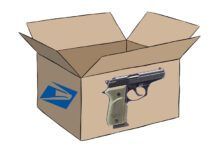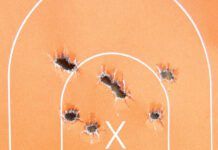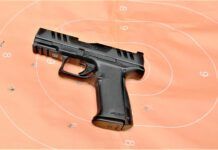The 357 Magnum is an excellent defensive cartridge. Pair it with a lightweight, compact revolver, and that is what we would call an excellent choice as a conceal-carry handgun. Our team has tested variants of the Ruger SP101 and S&W Model 60, but the S&W Model 60 Pro Series in 357 Magnum is a variant we have wanted to get our hands on for a while. We also wanted to see if the caliber choice would sway our recommendation on the established Ruger SP101 model.
The second Ruger SP101 we tested was chambered in 327 Federal Magnum, which was cataloged by Ruger from 2007 to 2011. As we noted in our first look at the gun in the April 2008 issue, Ruger and Federal teamed up to produce a cartridge/handgun combination that provided the power of the 357 Magnum but with less recoil and in a compact revolver that holds six shots rather than five shots. As a bonus, the 327 Fed Mag-chambered Ruger also accepts 32 H&R Mag, 32 S&W, and 32 S&W Long ammo. The footprint of the Ruger SP101 in 327 Fed Mag is basically same as the Ruger SP101 in 357 Mag, with a few exceptions.
All three double-action revolvers are built from stainless steel with similar barrel lengths, give or take three-quarters of an inch. All had exposed hammers, so single-action firing is possible. A transfer bar was built into the revolvers for safety. All three were built to last, even under a steady diet of hot loads. The lock up was tight on all three, and the chambers were all aligned with the bore, which we assumed but also verified. Fit and finish was very good on all three revolvers and that was exactly what we expected. The workmanship in these guns make them worth the cost.
Ruger SP101 Model #5718357 Magnum, $659
The SP101 was new back in 1989. The current model tested is the consummate snubnose revolver. The exterior of the revolver was smooth, with the only part likely to snag on a draw being the hammer spur. You can get the same Ruger without the hammer spur (Model #5720) for the same cost. The exterior finish was a matte stainless steel, except for the pinned serrated ramp front sight, which was matte black. The front sight could be replaced if needed. This SP101 did not have an adjustable rear sight; instead, a sighting groove was machined out of the top strap. The groove was stepped up at the rear to give the operator a deeper notch to index. The rear of the groove was milled out to help reduce glare. These rugged sights were well liked by the team. If we owned this revolver, we would add a smear of matte-black paint in the U-shaped cutout before the rear notch to eliminate any glare.
Like all Ruger DA revolvers, the cylinder catch is depressed to swing out the cylinder from the frame. It was smooth to operate. This small revolver locked up tight at the rear of cylinder into the back face of the frame. At the front a small detent in the crane snapped into the front of the frame. With the cylinder snapped into the frame, there was hardly any play. The shrouded ejector rod was smooth but did not fully eject 357 Mag empties; in fact, none of the revolvers fully purged empty cases from the chambers. A nice-to-have for the Rugers and the S&W would be chamfered chambers to aid in faster reloads.
The hammer spur was nicely checkered for a sure grip and the trigger was smooth. The team liked the trigger pull in both DA and SA, though they conceded the S&W was slightly smoother.
Testers felt the SP101 felt fuller in hand and liked the high grip. During firing, the rubber grip with ribbed polymer panels had less felt recoil than the S&W with the thin wood grip. A cut out in the left grip panel allowed use of a speed loader. When we conceal-carried the revolver, it was easier to reholster because the muzzle was tapered. We would have liked to see more of a chamfer on the front on the cylinder so holstering would be even easier. At the range, it shot to point of aim at 15 yards, which suited testers just fine.
Our Team Said:The SP101 is an older design, but it is still an excellent carry choice. Half the team would carry the SP101 hands down due to the excellent rubber grip, big chunky sights, and pointability. The group did admit the trigger of the Smith was slightly better.
Smith & Wesson Model 60#178013 357 Magnum, $799
The Pro Series is the line of guns that bridges the gap between S&W’s standard line and Performance Shop guns. The J-frame Model 60 weighed almost five ounces less than the SP101 327. In hand it felt thinner and smaller than the Rugers. If the Rugers were muscle bound weight lifters the Model 60 was a sinewy long distance runner. The grip was large compared to the grips of other S&W J-frame revolvers and was half checkered and textured giving it enough friction without it feeling toothy. The wood however transferred more felt recoil in the palm and web of your hand with 357 Mag loads compared to the Ruger 357. The teamed like the 357s because they could also fire 38 Special and 38 Special +P ammo through the revolvers. The 357 Mag/38 Spl ammo combination was hard to beat as it was easy to find and relatively inexpensive.
The stainless finish was matte; the Rugers were a tad shinier. The barrel on the Model 60 was slab sided and a cut out was in the ejector rod housing to lessen the weight of the revolver. The top of the barrel was serrated. The muzzles on all three pistols were crowned, in the event the pistol was accidentally dropped on the muzzle. The front edge of the Model 60’s barrel was sharper than either of the Rugers. We would rather it be rounded for ease in reholstering. We also want more chamfer on the cylinder for the exact same reason.
The sights on the Model 60 were the largest and most pronounced of the three tested. We liked the serrated front ramp as it had a night sight dot imbedded in the ramp. We thought this was an excellent feature, especially when things go bump in the night. The rear sight was adjustable for windage and elevation and the rear blade had a square notch and was finished matte black. The base of the rear sight was also serrated to kill and glare. The rear sight, we felt, was more susceptible to snagging than either of the Rugers.
The cylinder could be swung out when the cylinder latch was pushed forward. It was easy to operate and gave us a confident feeling. The ejector rod was knurled at the end so it stuck to our palm of our non-shooting hand when we ejected empties. It also housed a detent hole so a detent locked the ejector rod into the shroud. The hammer spur was smaller than the Rugers’ but still gave enough purchase for fast SA cocking. The trigger was smooth. Both the hammer and trigger were case colored and contrasted nicely to the matte stainless finish. The Model 60 was more comfortable to conceal carry than either of the Rugers due to less weight, and easier due to the thinner grip.
Our Team Said:This is an excellent choice for a concealable revolver because it is thin, lightweight, has an excellent trigger in both single action and double action, and has usable sights. The other half of the team would opt to carry the Model 60.
Ruger SP101 #5759327 Federal Mag., $600-$800
The longer barrel on the 327 Fed Mag gave this Ruger SP101 a different balance in hand, making it slightly heavier at the muzzle. Along with the longer barrel, this SP101 was different from the 357 Mag SP101 in rear sights and cylinder capacity. The 327 had a rear sight adjustable only for windage. We would have preferred a rear sight adjustable for both windage and elevation like the S&W Model 60. The matte-black rear sight was as fast to pick up as the Model 60 and faster than the SP101 with the groove rear sight.
The 327 Fed Mag is a snappy cartridge; less recoil than the 357 Mag revolvers but still a bit snappy. The grip of the Ruger made felt recoil quite tolerable. Even though 32 H&R Mag and 32 S&W cartridges can be used in this SP101, the team felt that those cartridges are even more difficult to find than 327 Fed Mag ammo. Federal, Speer, and Buffalo Bore are a few of the manufacturers that load 327 Federal Magnum.
Our Team Said:The 327 Fed Mag produced more muzzle energy than any of our 357 Mag loads, but ammo availability and bullet choices are significant concerns. As a result, we preferred to carry the 357 Mags, even with one fewer round.
Written and photographed by Robert Sadowski, using evaluations from Gun Tests team testers.




















